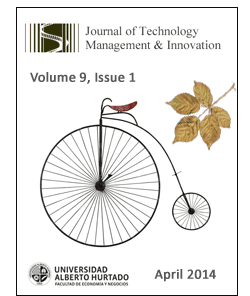Performance Evaluations of Technology Transfer Offices of Major US Research Universities in 2012/2013
DOI:
https://doi.org/10.4067/S0718-27242014000100008Keywords:
commercialization, innovation disclosure, license, patent, performance, startup company, technology transfer, universityAbstract
By analyzing the highlights of the major activities reported by the technology transfer offices (TTOs) of twenty US major universities, the performances of TTO activities are quantitatively assessed and the associated scores are compared with each other. The key performance indicators, which govern the success of the university technology transfer, are specifically selected and examined. Two normalized metrics, overall performance metric (OPM) and patenting control ratio (PCR), which are the representing combined indicators for the TTO performance, are developed and demonstrated. The two metrics are evaluated for each university selected and compared to specifically provide a comprehensive overview of how good is the TTO of a university as compare to those of its peers. Finally, the factors for a successful TTO are described and the major unsolved issues are also discussed.Downloads
References
ABRAMS, I., Leung, G., Stevens, A. J. (2009). How are U.S. technology transfer offices tasked and motivated- is it all about the money?. Research Management Review, 17(1), 1-34.
ANDERSON, T. R., Daim, T. U., Lavoie, F. F. (2007). Measuring the efficiency of university technology transfer. Technovation, 27, 306–318.
AUTM, AUTM 2011 (2012). Licensing Activity Surveys. Association of University Technology Managers, Deerfield, IL 60015, USA (www.autm.net/Home.htm).
BONI, A., Emerson, S. T. (2005). An integrated model of university technology commercialization and entrepreneurship education. Advances in the Study of Entrepreneurship, Innovation and Economic Growth, 16, 241-274.
BOYER, E. L. (1990). Scholarship Reconsidered: Priorities of the Professoriate. A special Report, The Carnegie Foundation for the Advancement of Teaching, Princeton, NJ, (www.hadinur.com/paper/BoyerScholarshipReconsidered.pdf).
BRITT, R. (2010). Academic Research and Development Expenditures: Fiscal Year 2009. Rep. No. NSF 11-305, US National Science Foundation, (www.nsf.gov/statistics/nsf11313/).
CARNEGIE FOUNDATION (2013), RU/VH: Research Universities (very high research activity). classifications.carnegiefoundation.org/descriptions/basic.php (Retrieved October 1, 2013).
COHEN, J. E., Lemley, M. A. (2001), Patent scope and innovation in the software industry. California Law Review, 89(1), 1-57, www.jstor.org/stable/3481172 (Retrieved Sept. 15, 2013).
FOLTZ, J., Barham, B., Kim, K. (2000). University and agricultural biotechnology patent production. Agribusiness, Vol. 16, No. 1, pp. 82-95.
HOEYER, K. (2008). The ethics of research biobanking: a critical review of the literature. Biotechnology & Genetic Engineering Reviews, 25(1), 429-452.
KUMARAMANGALAM, K. (2005). Do firms produce better quality research with greater academic collaboration?. Academy of Management, Annual Meeting Proceedings, 11-15, Academy of Management.
KURMAN, M. (2011). An index-based measure of university technology transfer. Int. J. Innovation Science, 3(4), 167-176.
LITAN, R. E., Mitchell, L., Reedy, E. J. (2007). Commercializing university innovations: Alternative approaches. Paper online via the Social Science Research Network, and on the Issues in Science and Technology, www.issues.org/23.4/litan.html (Retrieved Sept. 15, 2013).
NATURE (2010). Publish or perish. Nature 467 (7313), 252–252.
O'SHEA, R. P., Allen, T. J., Chevalier, A., Roche, F. (2005). Entrepreneurial orientation, technology transfer and spinoff performance of U.S. universities. Research Policy, 4(7), 994–1009.
PERLMUTTER, D. D. (2010). Promotion and Tenure Confidential. Harvard University Press, Cambridge, MA, (ISBN 9780674048782).
RESNIK, D. B. (2001). DNA patents and human dignity. J. Law, Medicine & Ethics, 29(1), 152-165.
ROESSNER, D., Bond, J., Okubo, S., Planting, M. (2009). The economic impact of licensed commercialized inventions originating in university research, 1996–2007. Report to the Biotechnology Industry Organization, Washington, DC.
ROGERS, E. M., Ying, Y., Joern, H. (2000). Assessing the effectiveness of technology transfer office at u.s. research universities. The Journal of the Association of University Technology Managers, 12, 47-80.
SHINE, W. D., Shane, S., Di Gregorio, D. (2003). The halo effect and technology licensing: the influence of institutional prestige on the licensing of university inventions. Management Science, 49(4), 478-496.
STEVENS, A. (2004). The enactment of Bayh–Dole. J. Technology Transfer, 29, 93–99.
THURSBY, J. G., Thursby, M.C. (2003). Industry/university licensing: characteristics, concerns and issues from the perspective of the buyer. Journal of Technology Transfer, 28(3-4), 207-213.
TRUNE, D. R., Goslin, L.N. (1998). University technology transfer program: a profit/loss analysis. Technological Forecasting and Social Change, 57(3), 197-204.
TSENG, A. A., Raudensky, M. (2015). Performances of technology transfer activities of US universities after Bayh-Dole Act. J. Economics, Business & Management, 3(6), 661-667,
WEST, D. M. (2012). Improving university technology transfer and commercialization. Issues in Technology Innovation, No. 20, 1-15, Center for Technology Innovation at Brookings.
XU, Z., Parry, M. E., Song, M. (2011). The impact of technology transfer office characteristics on university invention disclosure, IEEE Trans. Engineering Management, 58(2), 212-227.
YORK, A. S., Ahn, M. J. (2012). University technology transfer office success factors: a comparative case study, Int. J. Technology Transfer & Commercialisation, 11(1/2), 26-50.
Downloads
Published
How to Cite
Issue
Section
License
Copyright (c) 2014 Journal of Technology Management & Innovation

This work is licensed under a Creative Commons Attribution-ShareAlike 4.0 International License.












